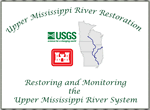|
|
 Background Background
Aquatic vegetation in the Upper
Mississippi River System (UMRS) provides food, spawning areas, and
shelter to fish, wildlife, and invertebrates. Aquatic vegetation is a
vital component of this nationally significant navigation and ecosystem
(Public Law 99-662, Upper Mississippi River Management Act of 1986). The building of locks and dams in the Upper Mississippi and Illinois Rivers
during the 1930s for commercial navigation greatly expanded the rivers'
backwater areas in which submersed aquatic vegetation flourished for many
years. However, after a severe drought in the basin, aquatic vegetation
in the Mississippi River experienced a drastic decline between 1989 and
1994 (Fischer and Claflin 1995; Rogers et al. 1995; Wiener et al. 1998;
Tyser et al. 2001). The causes of this decline are unknown, but may include decreased light availability because of phytoplankton blooms, depletion of nutrients during low flows, herbicides, and grazing by fish (Wiener et al. 1998). Current data indicate that the Upper Mississippi River above Dam 13 has rebounded from the severe declines in aquatic vegetation that occurred during the drought of 1987–89 and the flood of 1993.
Through the Upper Mississippi River Management Act of 1986, Congress established the Upper Mississippi River Restoration (UMRR; formerly Environmental Management Program) Program of the UMRS in 1986 to ensure the coordinated development and enhancement of the UMRS. The UMRR consists of five elements, including Habitat Rehabilitation and Enhancement Projects (HREP), Long Term Resource Monitoring (LTRM), Recreation Projects, Economic Impacts of Recreation Study, and Navigation Monitoring. The LTRM is administered by the U.S. Army Corps of Engineers and implemented by the U.S. Geological Survey Upper Midwest Environmental Sciences Center (UMESC) in partnership with the Illinois Natural History Survey, Iowa Department of Natural Resources, Minnesota Department of Natural Resources, Missouri Department of Conservation, and Wisconsin Department of Natural Resources.
Aquatic vegetation in the UMRS is monitored as a component of the LTRM along with fish and water quality in six key study reaches. Decadal systemic land cover/use information is also generated using aerial photos. In 2010, systemic lidar and bathymetry data collection were completed. Since 1998, five key pools were sampled for aquatic vegetation using a stratified random sampling protocol (Yin et al. 2000) including Pools 4, 8, 13, and 26 of the Mississippi River and La Grange Pool of the Illinois River. In 2005, Pool 26 and La Grange Pool were removed from the sample design because of budgetary cuts and aquatic vegetation low frequency of occurrence.
In 2001, Pool 11 was sampled as a pilot outpool sampling project. In 2002, four additional pools were sampled to help determine how representative the five key pools were of the UMRS. These included Pools 5, 7, and 12 of the Mississippi River and Alton Pool of the Illinois River.
The objective of the sampling was to accumulate data on
the distribution, frequency of occurrence, and relative abundance of aquatic
vegetation within pools over a long period (>50 years) using
a standardized protocol across the system. Although data on filamentous
algae and duckweeds were collected during sampling, they were not reported
here because our focus was on submersed, rooted, floating–leaf, and
emergent vegetation. The full suite of data (inclusive of submersed, rooted,
floating–leaf, emergents, algae, and duckweeds) is archived in
the UMESC database and is available online at http://umesc.usgs.gov/data_library/vegetation/vegetation_page.html.
From 1998 to 2002, an annual report was
written that summarized the data for that year. In 2003, the
format was changed to a Web-based annual update where all years of data
are presented in each table. Other vegetation information also is available using the Graphical Vegetation Database Browser. One can generate graphs depicting status and trend information (e.g., percent frequency, relative abundance, distribution maps) for aquatic vegetation. The downloading of summary statistics is also available.
Yin, Y., H. Langrehr, T. Shay, T. Cook, R. Cosgriff, M. Moore, and J. Petersen.
2009. Vegetation sampling in the Upper Mississippi River System: Annual
update. U.S. Geological Survey, Upper Midwest Environmental Sciences Center,
La Crosse, Wisconsin. An LTRMP Web-based report available online at http://umesc.usgs.gov/reports_publications/ltrmp/veg/vegetation_update.html. (Accessed Feb. 2009, with 2008 data.)
Content manager: Danelle Larson |






 Background
Background